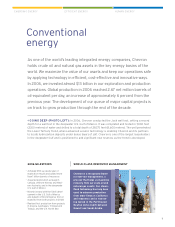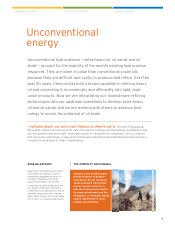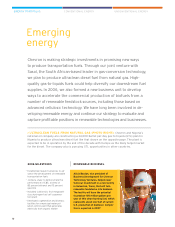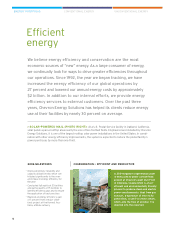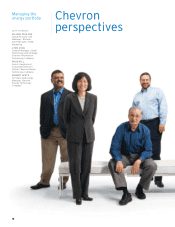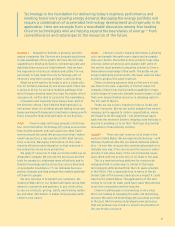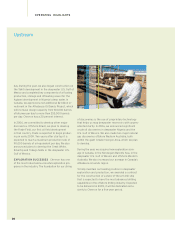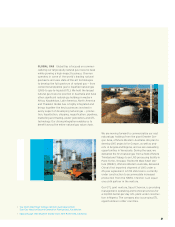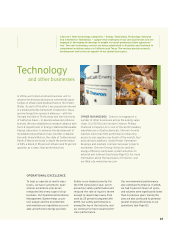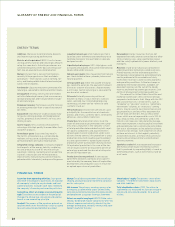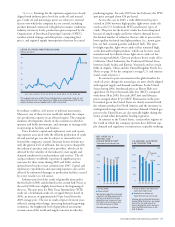Chevron 2006 Annual Report Download - page 19
Download and view the complete annual report
Please find page 19 of the 2006 Chevron annual report below. You can navigate through the pages in the report by either clicking on the pages listed below, or by using the keyword search tool below to find specific information within the annual report.
17
Technology is the foundation for delivering today’s business performance and
meeting tomorrow’s growing energy demand. Managing the energy portfolio will
require a combination of accelerated technology development and ingenuity in its
application. Here are excerpts from a roundtable discussion among four leading
Chevron technologists who are helping expand the boundaries of energy — from
conventional oil and natural gas to the resources of the future.
RAJESH :: Demand for biofuels is growing, and inte-
grated companies like Chevron are uniquely positioned
to take advantage of this growth. We have the full-scale
capabilities to develop biofuels to commercial scale and
distribute them across our retail network. And we have
the experience of doing so reliably and safely. For me,
personally, to help make this new technology part of
Chevron’s long-term energy portfolio is very exciting.
What we don’t want to do today is pick a single solu-
tion for biofuels, because no one knows what tomorrow
is going to bring. So we have multiple pathways that
we’re trying to develop down the road. No matter which
one pans out, we’ll be able to succeed in the marketplace.
Innovation and ingenuity have always been part of
the Chevron culture. I don’t believe that ingenuity is a
one-person show. It’s all about people talking to people,
teams working with teams and collectively coming up with
those innovative ideas that add value to our business.
LYNN :: Chevron deals with huge amounts of informa-
tion. Our Information Technology (IT) group serves more
than 63,000 network end-users and more than 7,600
servers around the world. We process more than 1 million
email transactions a day and about 140 retail transac-
tions a second. Managing information on this scale
requires effi ciency and integration so that everyone in
the enterprise can be more productive.
We apply IT resources to help us function better as an
integrated company. We provide the processes and the
tools for people to collaborate more effectively and to
transfer knowledge and best practices across divisional
or geographic boundaries. IT can stimulate business
process changes and help unleash the creative potential
of Chevron’s people.
We also leverage IT to benefi t our customers. We
created a Web site for our Global Lubricants group that
allows its customers and partners, in just a few clicks,
to see our products, pricing, safety and training materi-
als, and other information. It makes doing business with
Chevron a lot easier.
ROSS :: Chevron’s seismic imaging technology is allowing
us to see beneath the earth more clearly and accurately
than ever before. Recorded echoes produce huge data
volumes, which we process and analyze with some of
the world’s most powerful computing systems to form a
three-dimensional image of the earth. The better we can
image challenging environments, the fewer wells we have
to drill to produce the same reservoir.
These continuing advances help us fi nd more oil and
gas than in the past, especially in frontier areas. For
example, Chevron has built a leading capability in imag-
ing the shape of reservoirs beneath massive layers of salt
that cover large potential resources in ultradeep water in
the U.S. Gulf of Mexico.
Today, we use seismic imaging to help us locate and
extract resources. But we can easily imagine how seismic
imaging can be applied to carbon sequestration, where
we’ll want to do the opposite — put greenhouse gases
back into the reservoir. Seismic imaging could well play a
big role in enabling us to do that. That type of potential
innovation is tremendously exciting.
ROBERT :: There are vast reserves of oil shale in the
western United States. We are exploring technology — with
the help of partners like the Los Alamos National Labora-
tory — to turn this resource into commercial products in a
radically new way. If we can recover the resource under-
ground, it will solve many of the environmental issues
associated with the production of oil shale in the past.
This is a new technology platform for resource de-
velopment that in some ways is similar to the major
technological shifts derived from the U.S. space program
in the 1960s. This is especially true in terms of the po-
tential scale of the business and resource impact it could
have for the United States. The applications of this tech-
nology to recover oil shale could have value that extends
across the corporation and the industry.
Chevron’s philosophy on technology is very clear.
We’re not looking at repeating the same old technology,
because the same old technology gets you what you had
in the past. We’re looking at developing new processes
that will produce new results to unlock the potential of
this world-class resource.
17


